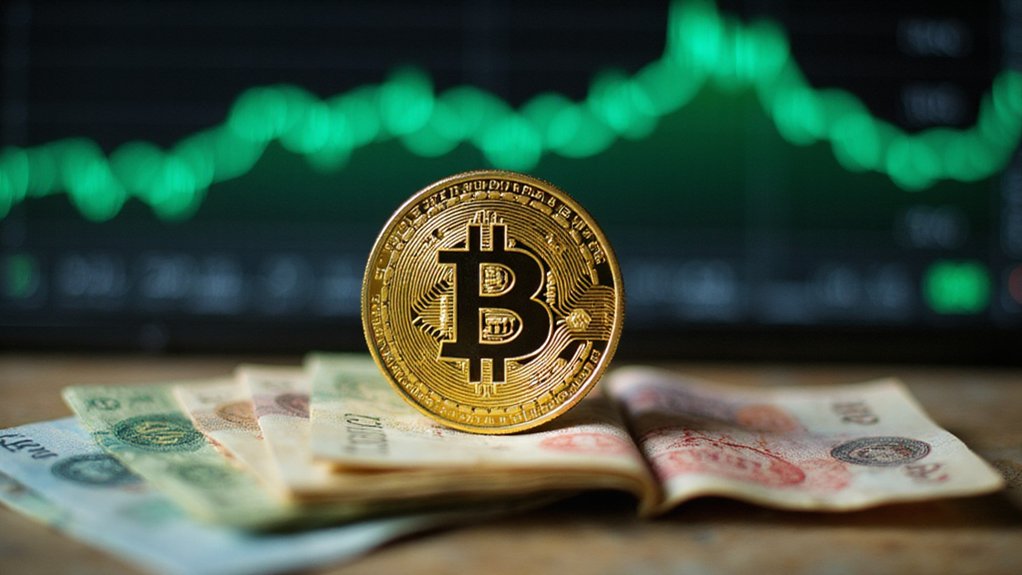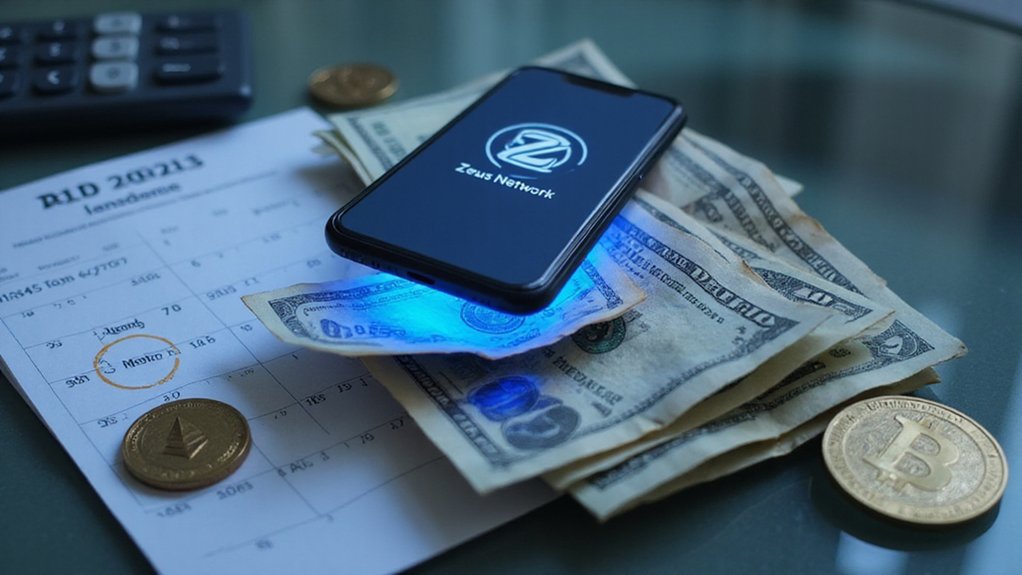Bitcoins derive value from mathematical scarcity (capped at 21 million), functioning as a borderless medium of exchange immune to central banking whims. Their worth stems from the decentralized blockchain’s cryptographic fortress, strengthened through network effects as institutional adoption transforms this former “internet money” into a legitimate asset class. The halving mechanism‘s systematic reduction of new coin issuance—most recently on April 19, 2024—creates a supply constraint against persistent demand. The valuation calculus becomes clearer with each regulatory clarification.

Why has a digital asset with no physical form, backed by no government, and understood by relatively few people become one of the most coveted financial instruments of the 21st century?
The answer lies in Bitcoin’s carefully engineered scarcity—a total supply capped immutably at 21 million coins—creating a digital parallel to precious metals that central banks cannot debase through capricious money printing.
Bitcoin’s fixed 21 million supply creates mathematical scarcity immune to the inflationary whims of central banking policy.
This mathematical certainty, combined with a transparent halving schedule that systematically reduces new coin issuance, establishes a deflationary pressure virtually unprecedented in modern monetary systems. The recent halving event on April 19, 2024, reduced the block reward to 3.125 bitcoin, further constraining the available supply. With each halving event, the cryptocurrency has historically experienced price spikes followed by subsequent market corrections.
Bitcoin’s value proposition extends beyond mere scarcity to its function as a borderless medium of exchange.
As merchants increasingly incorporate cryptocurrency payment options and digital payment infrastructures evolve, Bitcoin facilitates frictionless cross-border transactions—bypassing the labyrinthine inefficiencies of traditional banking networks (which, one might note, still occasionally rely on fax machines for international transfers).
This utility provides concrete value, particularly in regions where banking access remains limited or unstable.
The underlying blockchain technology—a decentralized ledger maintained by thousands of independent nodes—creates a security architecture resistant to manipulation by any single entity.
This cryptographic fortress, continually strengthened through network effects as adoption increases, presents a compelling alternative to financial systems vulnerable to both institutional malfeasance and geopolitical pressures.
Market sentiment and investment dynamics further bolster Bitcoin’s valuation.
Institutional investors, once dismissive of this “internet money,” now allocate significant capital to cryptocurrency positions as inflation hedges and portfolio diversifiers. The programmed inflation control mechanism that halves miner rewards approximately every four years helps maintain Bitcoin’s scarcity and potentially drives up its value as demand persists.
This institutional legitimization creates a virtuous cycle of increased liquidity, reduced volatility, and enhanced market stability.
Regulatory clarification, while progressing unevenly across jurisdictions, has gradually transformed Bitcoin from underground curiosity to recognized asset class.
As legal frameworks mature and tax treatments standardize, mainstream financial integration accelerates, expanding the potential investor base beyond early tech-savvy adopters to traditional market participants.
The resulting demand, when confronted with Bitcoin’s unyielding supply constraints, creates the fundamental economic tension that continues to drive its remarkable valuation trajectory.
Frequently Asked Questions
How Do I Safely Store and Protect My Bitcoin?
Secure Bitcoin storage necessitates multiple defense layers.
Experts recommend hardware wallets like Ledger or Trezor for cold storage, keeping private keys offline and impervious to digital threats.
One might combine these with hot wallets for daily transactions (though leaving significant sums in exchange accounts invites disaster).
Seed phrases—those cryptographic lifelines—should be recorded physically, stored in separate locations, and never digitized.
Regular security audits, software updates, and vigilance against phishing complete this prudent arrangement.
Can Governments Ban or Regulate Bitcoin Out of Existence?
Governments face substantial challenges when attempting to ban Bitcoin outright.
Its decentralized architecture—operating across a global network of nodes without central authority—creates an elusive target for regulators.
While nations can certainly restrict exchanges, criminalize usage, and impose onerous compliance requirements, Bitcoin’s peer-to-peer nature renders complete elimination virtually impossible.
Regulatory efforts typically focus on on-ramps and off-ramps rather than the protocol itself.
The question isn’t whether governments can ban Bitcoin, but whether such bans could ever be truly effective.
What Happens to Bitcoin During Economic Recessions?
Bitcoin’s behavior during economic recessions remains somewhat theoretical, given its relatively short history spanning just one major downturn.
While often touted as a hedge against economic instability, evidence suggests Bitcoin tends to correlate with traditional risk assets during crises—selling off when liquidity is needed.
Its theoretical anti-inflationary properties may eventually provide recession protection, but current market dynamics indicate Bitcoin still behaves more like a speculative investment than a safe haven during economic contractions.
How Does Bitcoin Mining Impact the Environment?
Bitcoin mining exacts a considerable environmental toll through its voracious energy consumption—primarily derived from fossil fuels—which generates significant carbon emissions (potentially reaching 0.7% of global CO2 output by 2027).
The process simultaneously produces substantial electronic waste from rapidly obsolete hardware, consumes precious water resources, and alters land use patterns.
Communities near mining operations face disproportionate exposure to PM2.5 pollution, while the industry’s global footprint remains stubbornly high absent meaningful shifts toward renewable energy sources.
Will Bitcoin Be Replaced by Newer Cryptocurrencies?
While Bitcoin faces competition from technologically advanced cryptocurrencies offering enhanced functionality, its replacement seems unlikely.
Bitcoin maintains dominant market capitalization, established network effects, and institutional adoption despite altcoins’ innovations in transaction speed and energy efficiency.
Its scarcity model (capped at 21 million coins) contrasts with many competitors’ supply structures, preserving value proposition.
Rather than displacement, the ecosystem appears to be evolving toward specialization—Bitcoin as digital gold and store of value, with altcoins serving diverse functional niches requiring different consensus mechanisms.









